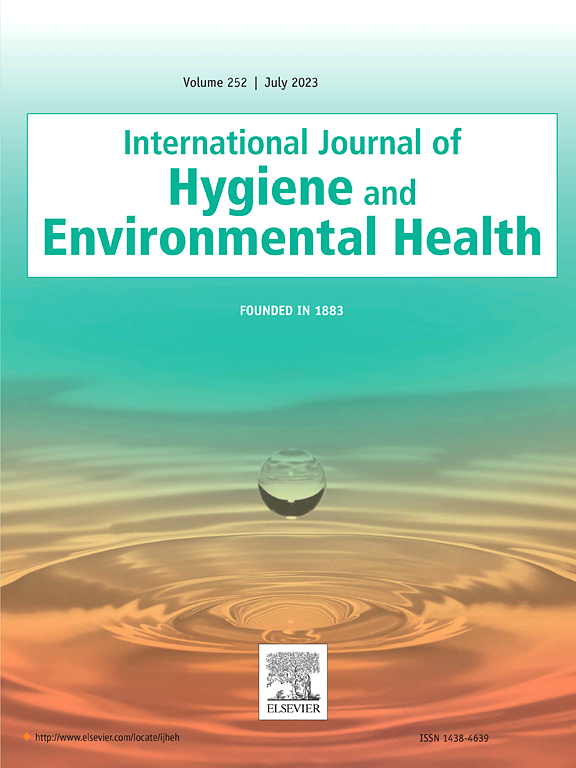人类生物监测健康指导值:HB2GV Dashboard 和 DEHP 案例研究
IF 4.5
2区 医学
Q1 INFECTIOUS DISEASES
International journal of hygiene and environmental health
Pub Date : 2024-11-25
DOI:10.1016/j.ijheh.2024.114490
引用次数: 0
摘要
2022 年,国际暴露科学学会(ISES)国际人体生物监测(i-HBM)工作组推出了一个免费的在线生物监测指导值库,称为人体生物监测健康指导值(HB2GV)仪表板。Dashboard 的目标是协助全球人类生物监测数据用户(如风险评估员、风险管理员)和人类生物监测计划,随时提供普通人群的指导值汇编。Dashboard 包含 150 多种化学品或其代谢物的约 600 个 HB2GV。尽管 HB2GV 有许多不同类型,但大多数都是生物监测等值 (BE)、人体生物监测 (HBM-I 和 HBM-II) 值或人体生物监测指导值 (HBM-GV)。对于刚刚接触人类生物监测的用户来说,理解不同类型的 HB2GVs 是如何得出的,以及如何在人类生物监测数据的背景下解释这些值可能比较困难。因此,有必要让用户了解现有指导值之间的差异,并帮助用户识别最适合其目的的 HB2GV。在此,我们总结了邻苯二甲酸二(2-乙基己基)酯(DEHP)这一案例研究化学品的 HB2GV 值的推导过程。我们之所以选择 DEHP,是因为从三种最常见的指导值类型(即 BE 值、HBM-I 值、HBM-GV 值)中可获得 36 个独特的 HB2GV。我们还对现有的 HB2GV 进行了比较,重点关注其推导方法、相对质量和可信度以及解释之间的差异。本案例研究为如何使用现有的 HB2GV 对人类生物监测数据进行基于健康的解释提供了指导,这些指导可应用于其他化学品。与任何其他类型的指导或监管值(如 RfDs、MRLs)一样,强烈建议进行周到的选择和使用。借助指导值对人体生物监测数据进行适当解释,可以改进决策,最终更好地保护公众健康。本文章由计算机程序翻译,如有差异,请以英文原文为准。
Human biomonitoring health-based guidance values: A case study of the HB2GV Dashboard and DEHP
In 2022, the International Society of Exposure Science (ISES) International Human Biomonitoring (i-HBM) Working Group launched a free, online repository of biomonitoring guidance values referred to as the Human Biomonitoring Health-Based Guidance Value (HB2GV) Dashboard. The goal of the Dashboard is to assist global human biomonitoring data users (e.g., risk assessors, risk managers) and human biomonitoring programs with a readily available compilation of guidance values for the general population. The Dashboard contains approximately 600 HB2GVs for over 150 chemicals or their metabolites. Although there are many different types of HB2GVs, most are Biomonitoring Equivalents (BEs), Human Biomonitoring (HBM-I and HBM-II) values, or Human Biomonitoring Guidance Values (HBM-GVs). For users new to human biomonitoring, understanding how the different types of HB2GVs are derived and how to interpret those values in the context of human biomonitoring data can be difficult. Therefore, there is a need to inform users of the differences among available guidance values and to help users identify the HB2GV that could be most suitable for their purposes. Here, we summarize the derivation of HB2GVs for a case study chemical, di-(2-ethylhexyl) phthalate (DEHP). We selected DEHP as there are 36 unique HB2GVs available from three of the most common types of guidance values (i.e., BE, HBM-I value, HBM-GV). We also compare the available HB2GVs with a focus on the differences among their derivation methods, relative quality and confidence, and interpretation. This case study provides guidance on the use of existing HB2GVs for health-based interpretation of human biomonitoring data that may be applied to other chemicals. As with any other type of guidance or regulatory value (e.g., RfDs, MRLs), thoughtful selection and use are strongly encouraged. Appropriately interpreting HBM data with the aid of guidance values can result in improved decision making which, ultimately, could lead to better protection of public health.
求助全文
通过发布文献求助,成功后即可免费获取论文全文。
去求助
来源期刊
CiteScore
11.50
自引率
5.00%
发文量
151
审稿时长
22 days
期刊介绍:
The International Journal of Hygiene and Environmental Health serves as a multidisciplinary forum for original reports on exposure assessment and the reactions to and consequences of human exposure to the biological, chemical, and physical environment. Research reports, short communications, reviews, scientific comments, technical notes, and editorials will be peer-reviewed before acceptance for publication. Priority will be given to articles on epidemiological aspects of environmental toxicology, health risk assessments, susceptible (sub) populations, sanitation and clean water, human biomonitoring, environmental medicine, and public health aspects of exposure-related outcomes.

 求助内容:
求助内容: 应助结果提醒方式:
应助结果提醒方式:


